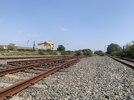History :
Stewartby Brickworks has stood in the small village of Stewartby since the 1920s. Stewartby, then named Wooton Pillinge, soon became the mainstay of brick production in the county of Bedfordshire.
In 1923 the two companies operating in the area merged to form the London Brick Company. Throughout the second world war, London Bricks from Stewartby and the other London Brick plants were used to build air raid shelters, official buildings, and airfield buildings. London Brick plants were also used to manufacture machine gun parts, and the great clay pits used to test tanks imported from America.
At the height of the industry’s production there were 167 brick chimneys in the Marston Vale. There are four chimneys still standing in Stewartby however at the time of operation it
had 37. It was also home to the UK's biggest kiln.
In the 1970s Bedfordshire produced 20% of England’s bricks. Stewartby produced 500 million bricks a year at its height of production.
The Brickworks was closed in 2008 after the operators were unable to bring the emissions of sulphur dioxide in line with regulations, and has sat empty ever since. Large parts have been demolished, and the rest is set to follow. A live railway runs through the site, however this has to be closed during high winds due to the risk of the chimneys falling. The chimneys are listed, however due to their structural instability they may have to be demolished for safety reasons. It is a real shame that this massive building, which produced the bricks that many people's homes were built with, so integral to the history of Bedfordshire, will soon be almost completely erased from the landscape it once dominated
the explore this place is very vast and takes a long time to get around so I have lots and lots of photos I have tried to capture it to the best of
My ability so it gets logged before its demolition I no it’s been captured by others but I have not edited any pictures it is just how it looks today : risks lots of pigeon poop , open drains dodgy roofs dodgy floors all the normal stuff really we had a nice walk around found some awesome
Stuff for pictures and some awesome construction shots as well cheers at bikinglyn for showing me around glad you had a good time also !
The first half is the factory side of the rail way track where the bricks where formed and quality insurance took place
let’s clock in and get moving at the stamp your card point




















Stewartby Brickworks has stood in the small village of Stewartby since the 1920s. Stewartby, then named Wooton Pillinge, soon became the mainstay of brick production in the county of Bedfordshire.
In 1923 the two companies operating in the area merged to form the London Brick Company. Throughout the second world war, London Bricks from Stewartby and the other London Brick plants were used to build air raid shelters, official buildings, and airfield buildings. London Brick plants were also used to manufacture machine gun parts, and the great clay pits used to test tanks imported from America.
At the height of the industry’s production there were 167 brick chimneys in the Marston Vale. There are four chimneys still standing in Stewartby however at the time of operation it
had 37. It was also home to the UK's biggest kiln.
In the 1970s Bedfordshire produced 20% of England’s bricks. Stewartby produced 500 million bricks a year at its height of production.
The Brickworks was closed in 2008 after the operators were unable to bring the emissions of sulphur dioxide in line with regulations, and has sat empty ever since. Large parts have been demolished, and the rest is set to follow. A live railway runs through the site, however this has to be closed during high winds due to the risk of the chimneys falling. The chimneys are listed, however due to their structural instability they may have to be demolished for safety reasons. It is a real shame that this massive building, which produced the bricks that many people's homes were built with, so integral to the history of Bedfordshire, will soon be almost completely erased from the landscape it once dominated
the explore this place is very vast and takes a long time to get around so I have lots and lots of photos I have tried to capture it to the best of
My ability so it gets logged before its demolition I no it’s been captured by others but I have not edited any pictures it is just how it looks today : risks lots of pigeon poop , open drains dodgy roofs dodgy floors all the normal stuff really we had a nice walk around found some awesome
Stuff for pictures and some awesome construction shots as well cheers at bikinglyn for showing me around glad you had a good time also !
The first half is the factory side of the rail way track where the bricks where formed and quality insurance took place
let’s clock in and get moving at the stamp your card point


